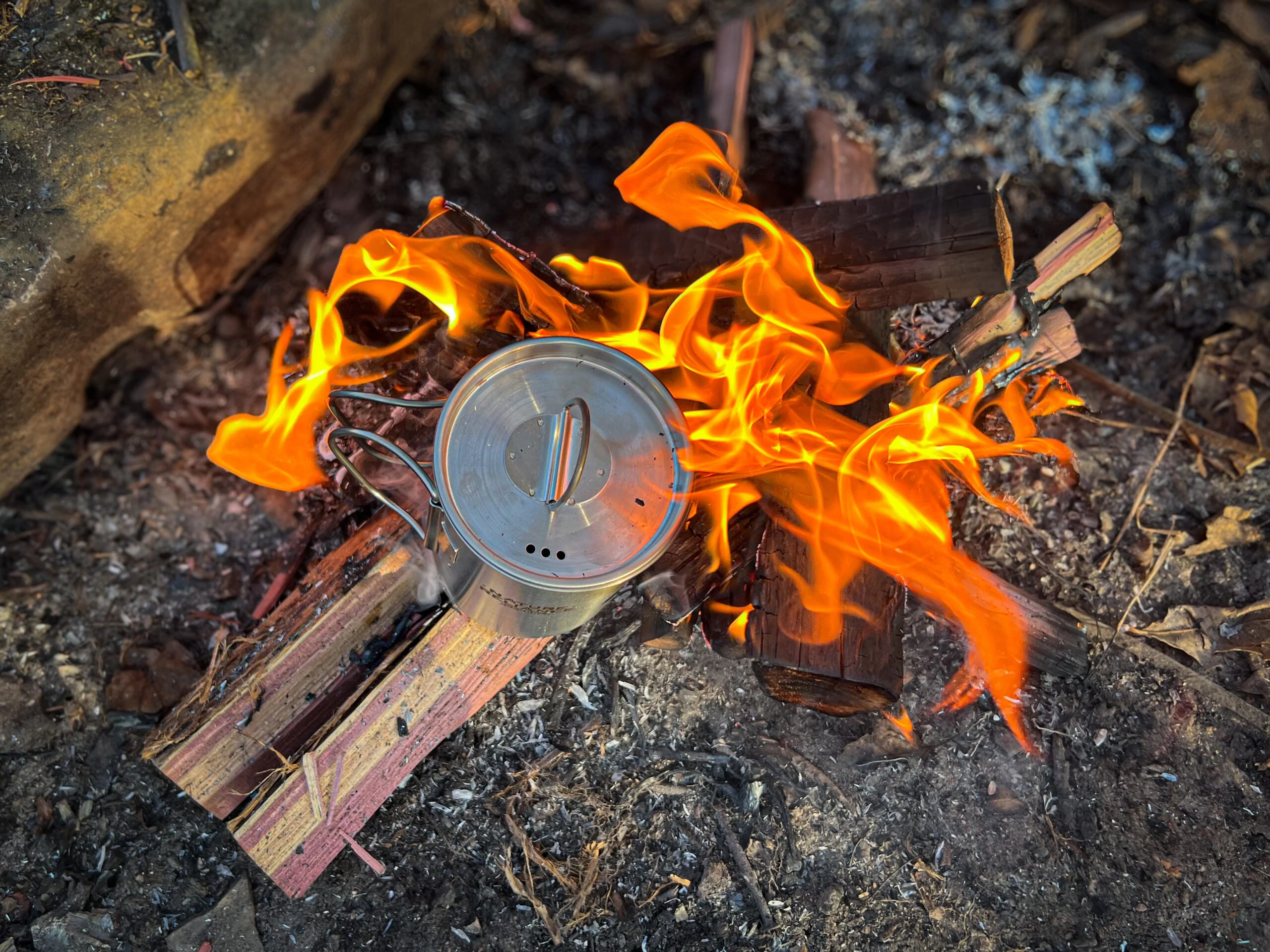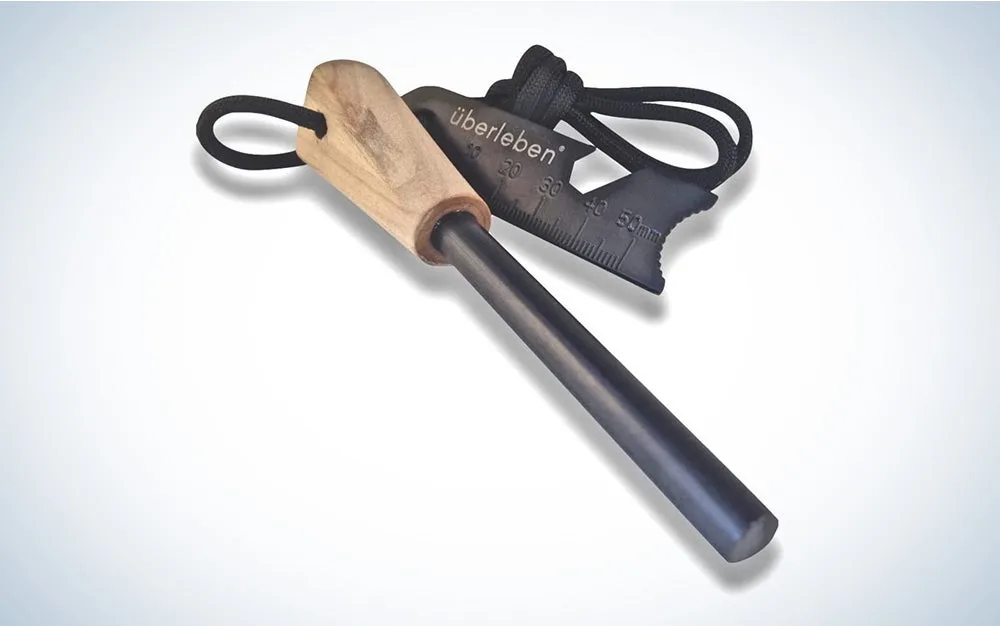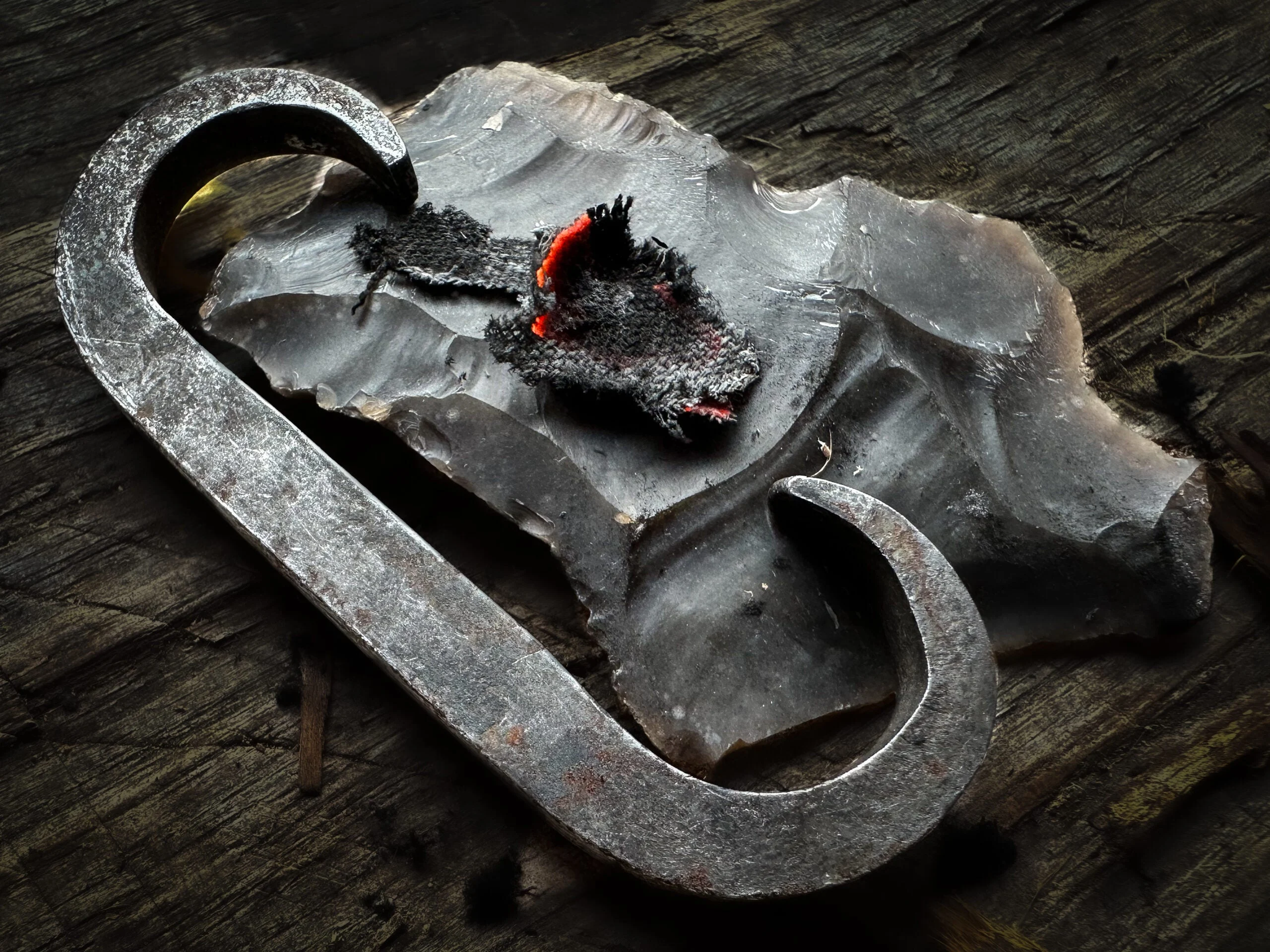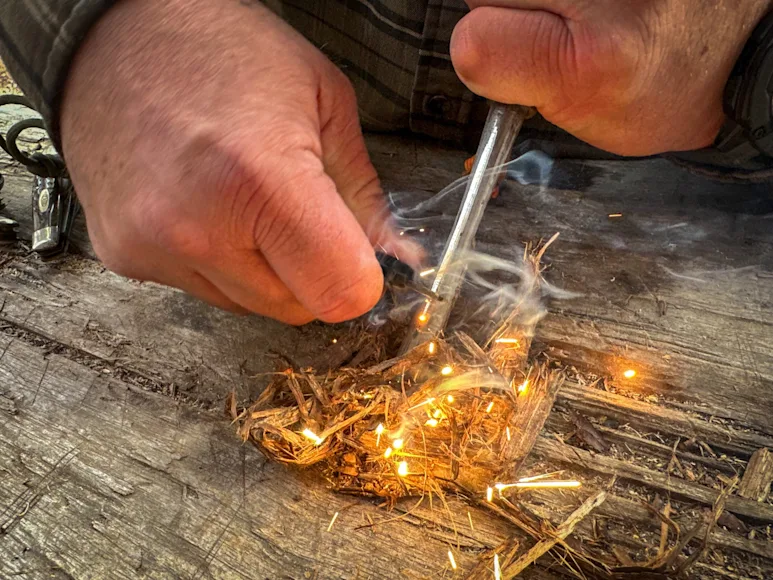I am a professional survival instructor
, and I teach how to start fire to groups of people ranging from elite military operators to school children. Fire building
is a critical skill. It is one of two primary focuses (shelter
being the other) in thermoregulation. The ability to start a fire in the wilderness can mean the difference between comfort and hardship or life and death.
While many of us rely on lighters (like the best camping lighters
, for instance), they can fail, run out of fuel, or get lost. I have firsthand knowledge of how crucial it is to have alternative methods in your skillset for knowing how to start a fire without a lighter. This knowledge boosts your confidence in the outdoors and deepens your connection with the natural world and our ancestors’ ways. Having numerous ways to start a fire offers a backup to the backup of thermoregulation security. This article will explore five ways on how to start a fire without a lighter.

Knowing how to start a fire is an indispensable survival skill. Jennifer Caudill
Method 1: Matches
Matches are the most straightforward alternative to a lighter. They are lightweight, portable, and easy to use. However, they can become useless if wet, so storing them in a waterproof container is vital. To start a fire with matches, first prepare your fire area. Gather tinder (small, easily ignitable materials like dry grass, dried inner bark, or small twigs), kindling (slightly larger sticks), and fuel wood (more significant pieces of wood).
How to Start a Fire Without a Lighter Using Matches
Prepare the Fire Site: Clear a space on the ground, protecting it from overhanging branches containing rain or snow. Remove all of the ignitable material from around the fire area. Put dried sticks down on the ground to create a fire. Create a small pile of fuel in the center.
Light the Match: Strike the match away from your body, ensuring it’s fully ignited.
Ignite the Tinder: Hold the match to the tinder until it catches fire. Shield the flame from the wind with your hand or body.
Build the Fire: Once the fuel is lit, gently add kindling, careful not to smother the flames. As the kindling catches, gradually add larger pieces of wood.
Maintain the Fire: Keep adding wood as needed, ensuring the fire gets enough air to breathe.
Remember, safety is paramount. Always have water or dirt nearby to extinguish the fire if necessary.
Method 2: Fire Steel and Striker
A ferrocerium rod (aka ferro rod) and striker, often part of a survival kit
, is reliable for starting a fire in various conditions, including wet weather. The rod creates sparks when struck by a hard object, usually a striker or the back of a knife blade. Practice is vital to mastering this technique, as the angle of the ferro rod to the striker will determine where the sparks go.

How to Start a Fire Without a Lighter Using a Steel and Striker
Prepare the Fire Site: As with matches, start by preparing your fire area with tinder, kindling, and fuel wood.
Position the Fire Steel: Hold the fire steel close to the fuel. If you’re using a knife as a striker, ensure the blade is facing away from you. Please do not use the sharp side of the blade, as this will dull it quickly. Please note some knives have polished or rounded spines that will make scraping difficult, if not impossible.
Strike to Create Sparks: Place the tip of your blade in the fuel and scrape your ferro rod across the spine to create sparks.
Ignite the Tinder: Aim the sparks at the fuel. It may take several strikes to catch.
Build and Maintain the Fire: Once the fuel ignites, proceed as you would with matches, gradually adding kindling and then fuel wood.
Method 3: Magnifying Glass
No surprise, but this method requires a sunny day and patience, which makes it less reliable than other methods in how to start a fire without a lighter. Still, it works and is worth discussing.

To start a fire with a magnifying glass, you’re going to need time—and a bright sun. Jennifer Caudill
How to Start a Fire Without a Lighter Using a Magnifying Glass
Prepare the Fire Site: Gather your tinder, kindling, and fuel wood.
Focus on the Sun’s Rays: Hold the magnifying glass between the sun and your fuel. Adjust the distance until you find the most minor, focused light point.
Ignite Tinder: Steady the focused light on a single tinder point. It will start to smolder and then ignite. This process can take time, so patience is essential.
Build and Maintain the Fire: Once the tinder is lit, add kindling and then fuel wood, as with the other methods.
Method 4: Bow Drill
The bow drill method is a traditional technique that requires practice and patience. It involves using a bow to rotate a spindle against a fireboard, creating friction and heat. This method requires significant practice to master the coordination and pressure needed.
How to Start a Fire Without a Lighter Using a Bow Drill
Create Your Tools: You’ll need a bow, a spindle (straight, dry stick), a fireboard (a flat piece of wood with a notch), and a bearing block (to hold the top of the spindle). I like a mildly flexible bow about the same distance measured from the middle of my hand to my elbow. The spindle should be about the length of your outstretched thumb and pinky finger. It helps many beginners if the spindle and fireboard are of the same wood. This should be medium-density and not too hard. A field test is to press your thumbnail into it. If it makes an indentation, it is probably good to go. If it doesn’t, the wood is too hard. The bearing blog, on the other hand, should be challenging and dense.
Prepare the Fire Site: Set up your tinder, kindling, and fuel wood.
Use the Bow Drill: Place the spindle into the notch of the fireboard. Use the bow to rotate the spindle rapidly. This action generates heat and creates a spindle and board dust in the notch. With continued pressure, this board dust will create an ember
Transfer the Ember: Carefully transfer the ember to your fuel.
Build and Maintain the Fire: Blow gently on the fuel to ignite it, then proceed with the other methods.
Method 5: Flint and Steel
Flint and steel is another near-primitive technique that creates sparks. This is the method that many of the frontiersmen and mountain men would have used in the late 1700s to early 1800s.

A char cloth can be made from old blue jeans or dried wood. Jennifer Caudill
How to Start a Fire Without a Lighter Using Flint and Steel
Prepare the Fire Site: Assemble your tinder, kindling, and fuel wood. Again, for emphasis, keep these materials on a fireplace setup that keeps them from the cold and wet ground.
Prep Your Char Material: You should have char cloth ahead of time to make this work. Char cloth is any organic material that you can turn into thin charcoal—usually made in a metal container that keeps most oxygen away from it as it burns. Cotton clothing like old blue jeans, dried hunk wood, or grass makes excellent char materials.
Create an Ember: Place your char on your flint piece. Strike the steel against the flint. This will create very small shavings of hot steel and strike the char. Move the char to your tinder material.
Build and Maintain the Fire: Blow gently on the tinder to ignite it, then add kindling and fuel wood.
Understanding the Triangle of Fire
Three things are needed to start a fire, often called the “triangle of fire.” They include:
An ignition source
A fuel source
Oxygen
Keep that in mind as you work on each of the fire-starting methods above. Starting a fire without a lighter involves using alternative methods to generate heat and ignite a fuel source. The key is to create enough friction or focus enough heat to light tinder, igniting kindling and eventually fueling wood. Each of the five methods we’ve discussed has its unique approach: Matches are straightforward; fire steel and striker use sparks; a magnifying glass focuses sunlight; the bow drill relies on friction; and the flint and steel have sparks but in a different manner. Understanding these methods provides a range of options depending on the resources available and the environmental conditions you’re facing. Mastering these techniques ensures you can start a fire in almost any situation, a crucial skill for any outdoor enthusiast.

Knowing how to start a fire in a survival situation can be a significant morale boost. Jennifer Caudill
FAQs
Q: Can you start a fire without a flame?
Yes, fire can be started without a visible flame using methods like friction-based fire making, including the bow drill technique mentioned above.
Q: Can fire burn with just oxygen?
No, fire requires three elements known as the fire triangle: fuel, heat, and oxygen. Without one of these components, fire cannot sustain itself. Oxygen acts as a supporter for the combustion process, allowing fire to burn.
Q: Do fires need heat to start?
Yes, heat is essential for initiating the combustion process and starting a fire. Heat can be generated through various means, such as friction, sparks, or a heat source like a match, lighter, the sun, or a magnifying glass. Once the heat is sufficient, it ignites the fuel, leading to a self-sustaining fire.
Q: How do you assemble a fire so that it’s ready to light?
Gather dry tinder, such as birchbark, and a large amount of dry twigs for kindling. Then, get larger pieces of firewood. Begin assembling a fire by laying down your tinder, placing kindling on top of it (use more kindling than you think you need). Then, put your larger firewood pieces on top of that, surrounding it in a teepee structure. You can also put them around the tinder and kindling in a log cabin, making sure the firewood logs are laid in so that they touch the kindling beside it, laying firewood legs across the top of the log cabin structure too. Be sure that some tinder, such as bark or paper, is sticking out from the bottom of the ready-to-light fire so that you can more easily light it with a match or lighter. It’s a good idea to leave an assembled fire like this in the wood stove of your cabin.
Q: What is the fastest way to put out a fire?
The fastest way to extinguish a fire depends on the type and size of the fire. For small fires, smothering the flames with a blanket, kicking dirt on it, or stomping it out with your boots can be effective. Of course, a fire extinguisher works well too. For larger fires, such as bonfires, water is your best bet. It’s a good idea to have easy access to water when you have a fire. Remember to always keep fires in control and don’t leave them behind until they’re out. The rule of thumb is that, if the coals are too hot to pick up, it’s not out yet.
Final Thoughts on How to Start a Fire Without a Lighter
With each of these methods, remember that doing them effectively boils down to the science of the fire triangle. If something is not working, then assess whether it is the ignition, the fuel, or the oxygen. Once that is determined, you can fix the issue and practice more to perfect your technique.


